| Recall that the most common metric units of length used are the kilometre (km), the
metre (m), the centimetre (cm) and the millimetre (mm). These units of
length are related as follows:

Note that we would measure the:
- thickness of the rubber sheet for a table tennis bat in millimetres.
- width of a television screen in centimetres.
- width of a road in metres.
- distance between two airports in kilometres.
Various instruments are used to measure length. For example:
- rulers and tape measures are marked in millimetres or
centimetres to measure shorter lengths accurately.
- a trundle wheel is used to measure length to the nearest metre.
Note that a counter may be attached to the trundle wheel to count
metres.
- a car's odometer often measures distance in tenths of a
kilometre.
Converting Metric Units
We know that:

This suggests that:
- To convert length from a larger unit into a smaller unit, multiply by the
relevant power of 10.
- To convert length from a smaller unit into a larger unit, divide by the
relevant power of 10.

You should be able to work confidently with metric units to solve
problems in daily life.
Example 1
Convert the following measurements to the units indicated:
a. 7 cm to mm
b. 8 m to cm
c. 9 km to m
Solution:
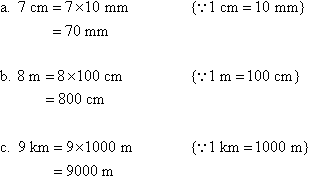
Example 2
Convert the following measurements to the units indicated:
a. 6 m to mm
b. 4 km to cm
c. 3 km to mm
Solution:


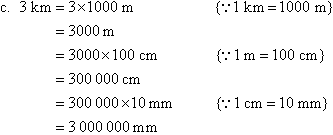
Example 3
Convert the following measurements to the units indicated:
a. 62.8 cm to mm
b. 48.7 m to cm
c. 8.26 m to mm
d. 4.75 km to mm
Solution:



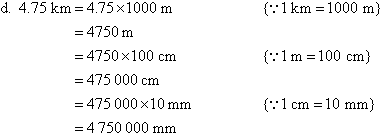
Example 4
Convert the following measurements to the units indicated:
a. 975 m to km
b. 650 cm to m
c. 8000 mm to m
d. 950 000 cm to km
Solution:


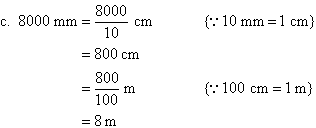
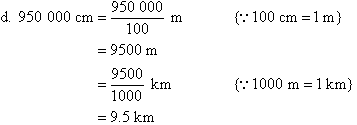
Key Terms
length, metric units of length, kilometre, metre, centimetre, millimetre, ruler, tape measure, trundle
wheel, odometer |